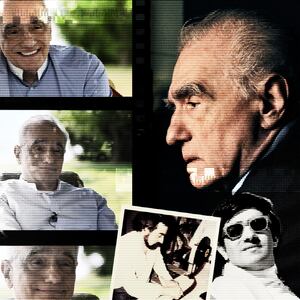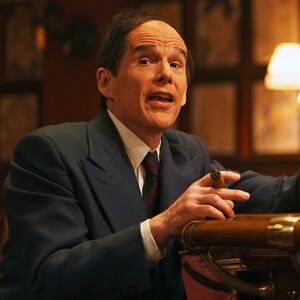The Grabber (Ethan Hawke) is resurrected for more kid-stalking mayhem in Black Phone 2.
Yet Scott Derrickson’s icy sequel plays by considerably different rules than its 2021 predecessor. Taking a decidedly Nightmare on Elm Street-ish tack (with a healthy dash of Friday the 13th thrown in for good measure), the writer/director’s 1982-set follow-up (in theaters now) operates in a sinister slumbering haze that enhances its dark fantasticality.
Sacrificing jolting frights for fugue-state ominousness, it’s a film whose tension (and inventiveness) waxes and wanes, although courtesy of Hawke’s unforgettable masked fiend, it continues to boast an iconic horror movie visage destined to ruin viewers’ sleep.
Four years after the events of the first film (which was based on a short story by Stephen King’s son Joe Hill), teenage Finney (Mason Thames) has assumed the mantle of his dearly departed buddy Robin as his school’s resident tough guy, thrashing a new kid in the playground until he bleeds.
This worries his sister Gwen (Madeleine McGraw), who’s being pursued by Robin’ younger brother Ernesto (Miguel Mora, who previously played Robin) and who’s plagued by psychic dreams that largely have to do with children being brutally murdered in the snow by an unseen assailant. This is somehow related to Hope (Anna Lore), a girl who in 1957 speaks to Gwen from a payphone at a Christian youth camp at Alpine Lake.
When Gwen researches this pious getaway, she realizes that her mom once worked there. With considerable prodding, she convinces Finney to join her at the wintery outpost to work as CITs—an idea that goes over well with their dad Terrence (Jeremy Davies), who’s nearly three years sober and done, apparently, with belt-beating his offspring.
Finney agrees to this excursion because he wants to protect Gwen (including from Ernesto, who’s tagging along) and, also, because he believes in his sister’s paranormal abilities. Further motivating him is a desire to flee his own problems—namely, the incessant ringing phones that follow him wherever he goes.
Finney refuses to engage with those on the other end of the line (he simply states, “I’m sorry but I can’t help you” before hanging up), since they’re restless spirits in need of help with their troubles. To quell his fears and fury, he’s additionally taken to smoking marijuana, a coping mechanism that’s turned him into a sullen, angry sort of zombie, if done little to halt his paralyzing visions of the Grabber’s smiling face.
Even before Gwen, Finney and Ernesto arrive at Alpine Lake, Black Phone 2 has set up shop in a netherworld between reality and the afterlife. Gwen traverses this liminal space as if pulled by invisible and incomprehensible forces, and Derrickson shoots this phantasmagoric action in scratchy, jittery Super 8 that has become the director’s preferred format for sequences of child suffering.
Gwen’s dreams invariably draw her to the home of the Grabber, whose basement’s black phone is still a conduit for communing with the dead, and which is still inhabited by the specter of the Grabber himself, no matter that Finney fatally strangled him at the conclusion of their initial saga. Not that the Grabber is confined to simply his suburban abode; upon making it to the camp, Finney receives a call from his old tormentor, who lets him know that “Hell isn’t flames, it’s ice!”
Black Phone 2 largely takes place at the camp, where Finney, Gwen, and Ernesto become trapped due to a raging blizzard. Their sole compatriots are the establishment’s owner and director Armando (Demián Bichir), his niece Mustang (Arianna Rivas), and his employees Kenneth (Graham Abbey) and Barb (Maev Beaty), the last of whom is the true-blue zealot of the group, chiding Gwen for her blasphemous mouth and insolent attitude.
Derrickson and C. Robert Cargill’s script is laced with references to Gwen and Finney’s religiosity—their late mother was devout; their dad is a non-believer; and Gwen has embraced some form of Christian faith—which is meant to give the material its spiritual heft. Alas, the film doesn’t do much with those ideas, save for positing the Grabber as an unholy child murderer whose time in Satan’s company has stripped him of the final vestiges of his humanity.
Fortunately, Black Phone 2’s chilly setting is a nice change of pace for the series, as well as a fitting reflection of its main characters’ bitter emotional and psychological states, and in place of their prior effort’s rather straightforward abducted-child conceit, Derrickson and Cargill smartly mix things up by going full-tilt hallucinatory.

There are times when the film’s fighting-undead-killers-in-dreams action feels derivative of Wes Craven’s seminal Freddy Krueger-led franchise, and yet thanks to a grainy old-school visual sheen, the proceedings boast their own uniquely unreal atmosphere. Moreover, there are a handful of memorable sights—the highlight being that of the Grabber ice-skating out of the mist and across a frozen pond to attack Finney, Gwen, and their compatriots with an axe—to offset the fact that DP Pär M. Ekberg’s nocturnal cinematography occasionally devolves into murkiness.
Derrickson only attempts one genuine jump scare, instead focusing on creating a mood of illusory menace, and Black Phone 2 is creepiest whenever Hawke’s grinning psychopath is on-screen—which, it must be said, isn’t quite often enough. Nonetheless, the film explains his rebirth with some tossed-off exposition that allows him to function as a legitimate boogeyman, and Hawke laces the villain’s every line with cruel, taunting hostility.
His poised, arrogant body language as threatening as his ear-to-ear leer, the Grabber is embodied by the actor as the most monstrous sort of abuser, and the director’s fondness for creating echoes between this tale and its ancestor—be it via literal flashbacks or sequences such as one of the Grabber chopping ice in harmony with Armando, which parallels Finney and Robin’s ghostly The Black Phone fight training—lends the antagonist an eternal-wraith quality.
Plunging headfirst down a life-after-death rabbit hole, Black Phone 2 seeks closure for Finney and Gwen—siblings bonded by trauma, rage, grief, and uncanny powers—at the same time that it establishes a narrative foundation for future films. Whether or not that’s in the cards, however, Derrickson and Cargill’s series remains a distinctive nightmare defined by a malevolent mug that any horror aficionado could love.









